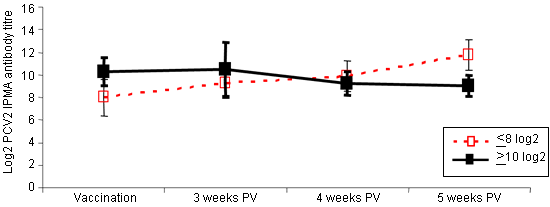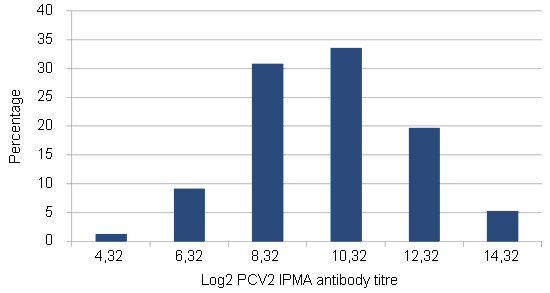It is well known that the immune system of the pig plays a key role in controlling infection by porcine circovirus type 2 (PCV2), keeping it subclinical in most cases. However, a variable proportion of pigs in a farm may develop postweaning multisystemic wasting syndrome (PMWS), a multifactorial acquired immune deficiency syndrome. Unfortunately, the precise immunological mechanisms by which a pig gets a subclinical infection or develops PMWS are still poorly known.
Even in such scenario of knowledge gap, PCV2 vaccines were developed. In fact, current commercial products show great efficacy to control PMWS, and even to counteract the subclinical effects of PCV2 infection. A considerable reduction in PCV2-associated productive losses has been observed in growing pigs, either vaccinated or originating from vaccinated breeding herds. Thus, improved average daily gain and feed conversion, decreased mortality rates and reduced medication costs are some of the benefits observed in vaccinated farms.

Figure 1. Profile of PCV2 IPMA antibody titres of a group of PCV2 vaccinated pigs at 3 weeks of age (single dose), and monitorization of antibody response at 3, 4 and 5 weeks post-vaccination (PV). Pigs were divided based on antibody titres at vaccination time: those with mean IPMA antibody titres ≤8 log2 and those with ≥10 log2 (adapted from Fort et al., 2009, Vaccine, 27: 4031–4037).
It is generally assumed that the main basis for PCV2 vaccine efficacy relies on the protective effect of anti-PCV2 antibodies, either passively acquired (sow vaccination) or actively induced (piglet vaccination). Also, cellular immunity is apparently a requirement for full vaccine efficiency. It is also worth mentioning that high levels of maternally derived antibodies (MDA) can interfere with active seroconversion following one-dose vaccination under experimental conditions (Fig. 1). Specifically, it has been shown that IPMA (immunoperoxidase monolayer assay) antibody titres beyond 10 log2 interfered with the humoral response development following PCV2 vaccination. Therefore, the likelihood of MDA interference in a pig population might depend on the antibody titres of piglets at vaccination time. It is well known that such titres are quite variable in a pig population, depending on the variability of PCV2 sow titres. Moreover, it has also been shown that a proportion of experimentally PCV2-challenged pigs does not get infection depending on the PCV2 antibody titre at challenge. Therefore, it seems obvious that MDA exert certain effects on both PCV2 infection and seroconversion upon PCV2 vaccination.
In consequence, the effect of MDA on productive parameters upon PCV2 vaccination is under debate. It has been published that vaccines overcome such potential interference since they are able to protect a pig population from PMWS development and improve productive parameters of the population as a whole even in presence of MDA. However, one issue is to overcome maternal immunity, which is true for all PCV2 vaccines in the market, and another is whether the most from these vaccines is achieved independently of the PCV2 antibody titre at vaccination. From a biological point of view, one should interpret that a group of animals tends to organize as a normal distribution in regards serological values (Fig. 2). In such scenario, the proportion of animals represented in one of the edges of the curve (those with the highest PCV2 antibody titres), would potentially have a higher risk of MDA interference. This issue has been minimally tackled from a scientific point of view, probably because of the great efficacy already demonstrated by PCV2 vaccines. However, the extremely broad use of such products in the last years, and expectedly in the future, increases the likelihood of potential vaccine failure scenarios. It is very probable that most of such putative failures may be caused by a number of issues related much more with human effects (vaccine conservation, application, etc.) rather than lack of efficacy of the product. But, in any case, those situations must be investigated and age at PCV2 vaccination in relation to the MDA titres is one of the issues to study.
Based on the PCV2 antibody and infection dynamics in a population of pigs, a “vaccination window” (ideal timing for applying the vaccine) has been proposed in a theoretical form. Such “window” is defined as the range of antibody titres at which piglets should be vaccinated to minimize interference with MDA and, at the same time, ensure the development of protective immunity before PCV2 exposure. Obviously, this approach is based on a population basis, but variation may not only apply among individual animals (Figure 2), but also among farms (not all farms have the same mean antibody titres against PCV2 at vaccination). So, are we getting the best from PCV2 vaccines by deciding a given age at vaccination without taking into account the particularities of each animal population?

Figure 2. PCV2 IPMA antibody titre distribution in a population of 152 pigs at weaning. Antibody titres represent a normal distribution



